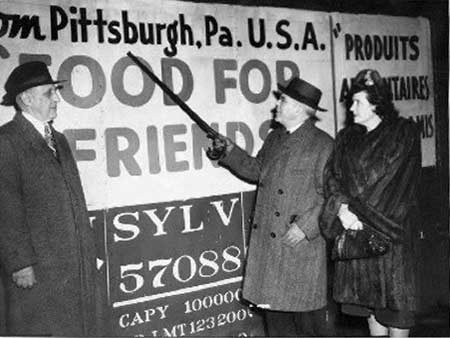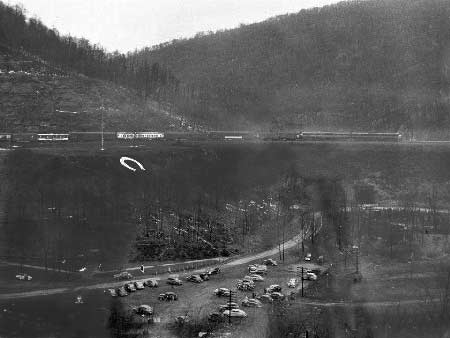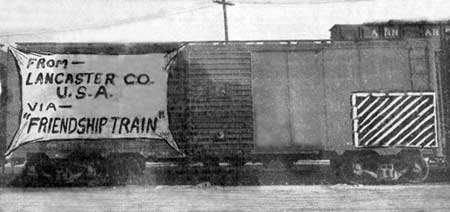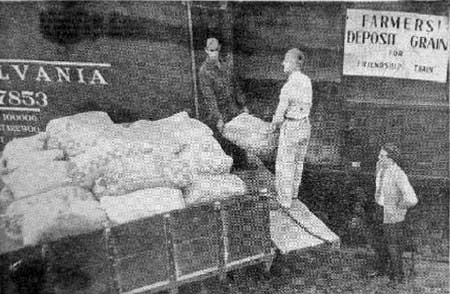
The 1947 Friendship Train in Pennsylvania On a chilly and drizzling Saturday evening the Friendship Train rolled into East Liberty Freight Yard at Penn Avenue and Dahlem Street in Pittsburg. Railroad workmen had prepared the yard for the welcoming ceremony and the attachment of the cars. The Pittsburgh Press had estimated that between 3,000 to 5,000 would attend the celebration for the train, but only about 500 were there. Most were likely deterred by the weather. The City Police and Firemen�s Band launched the entertainment, and local radio personalities and night club acts performed. Mayor David H. Lawrence and J. S. Crutchfield, chairman of the Pittsburgh Citizens Food Committee spoke at the event.
Some of the many contributions filling Pittsburgh�s boxcars were 1,600 pounds of assorted foods donated by the Italian Sons and Daughters, the Independent Order of the Sons of Italy, and the Huntingdon Workers. Eighteen hundred stores had placed food bins for people to make their deposits. Outlying communities were asked to contribute cash which would be used later to purchase food in New York. They donated at least $1,000. West Virginia sent its donation to the food train to Pittsburgh. Parkersburg shipped an entire carload, and Fairmont and Charleston each contributed quarter carloads. Johnstown, 100 miles east, was the next destination. The fact that the city was an unscheduled stop reflects the unbridled enthusiasm for the Friendship Train. Johnstowners refused to be omitted from America�s wave of generosity. Congressman Harve Tibbott and the Pennsylvania Railroad arranged for the stop. The Blue Devils Trumpet and Drum Corps of the American Legion Post 294 and a huge crowd greeted the train. According to the Johnstown Tribune thousands more were at the Iron Street and Prospect viaduct. Johnstown and Windber in neighboring Somerset County plunged into collecting for the train. School children in Cambria County, as well as civic organizations, such as the Barnesboro Lions Club and the Windber Fire Company donated thousands of dollars. Central City, at that time a community of about 2,000 residents, collected $4,000. Residents of Johnstown had collected enough to purchase an entire boxcar of milk, which for reasons unclear, had been added to the train in Chicago. The train next sped off from Johnstown to Altoona.
Even though the area�s first snow had fallen the previous day, thousands of enthusiastic Altoona citizens waved and cheered as the diesel-powered Friendship Train roared into the PRR station on November 16. The Hollidaysburg High School Band and MacCaabees Drum and Bugle Corps added to the festivities. Mayor H. Atlee Brumbaugh and a small delegation were already on board, having, as was customary for local officials, boarded the train several stations back. The fundraising drive, lead by Mrs. Julia Homer, resulted in an impressive $7,409, including the $1,341 donated by the miners of Clearfield. The food drive, headed by Lee. J. Buechele, unquestionably succeeded. Altoona bakers alone contributed one boxcar of flour, one of the two cars from Altoona proper. Bellefonte, Bedford, and Lewistown each contributed a full boxcar of flour. Among the other towns eagerly donating were Roaring Spring, Tyrone, Bellwood, Williamsburg, Claysburg, and Hollidaysburg. The total contribution for this central area of Pennsylvania was six boxcars. Altoona also had a bit of a personal connection with the train as native, Marion Canty, was Pearson�s secretary and was traveling with the train. After two hours of celebration, the train left for Huntingdon. Although a stop at Huntingdon was not schedule, the people insisted that the train stop for their contributions. Despite being three hours later than expected and despite a sharp wind and sub-freezing temperature, the delay did not dampen the spirit of the 4,000 waiting for the train. The PRR had installed a large generator to provide lighting, and Juniata College had lent rope to help the police keep people away from dangerous areas. The Lions Club had organized the food drive and their members, along with the Sea Scouts and the Air Scouts, had loaded the boxcar. Huntingdon�s boxcar of flour and wheat was ready to go when the Friendship Train roared into the PRR station. WHUN broadcast the entire program from a flatbed car. Chief Burgess Loyal D. Daubenspeck and Robert Powell, chairman of the Friendship committee, spoke at the welcoming ceremony. A half-hour after its arrival, the train roared off, leaving Huntingdon County residents with a proud glow. Harrisburg the next morning had a brief but highly publicized ceremony for the Friendship Train. The John Harris High School Band opened the ceremony. Among those speaking were Mayor Howard E. Milliken, and Johns S. Branyon, President of the Harrisburg Jr. Chamber of Commerce and chairman of the local food train committee. Branyon presented Harrisburg�s nine cars to Drew Pearson. Thousands witnessed the ceremony. The excitement was heightened, no doubt, by the presence of the Freedom Train.* International press covered this important moment. Time and Life magazines took still pictures; major motion picture companies shot newsreels; the BBC taped and transcribed the program for rebroadcast on an international level. Four of the boxcars coupled to the train in Harrisburg had come from York and Williamsport. York�s campaign brought unusually large contributions from industry and city and county schools. Seniors at New Freedom High School collected $177 in a door-to-door canvas; York city schools alone contributed almost $800. Local wholesale groceries took orders by the case at wholesale prices. Each package carried a message in French and Italian, �To our friends in France and Italy from your friends in Pennsylvania.� Williamsport sent two boxcars of flour to Harrisburg. Cheerful citizens washed, polished, and shellacked the engine which would tow the cars. Despite the falling snow, the Williamsport High School Band played for one-half hour before the brief ceremony, hailing the Saturday morning departure. Station WRAK broadcast the ceremony, emceed by Mayor Leo C. Williamson. Rev. Frederick E. Christian, the principal speaker, developed the theme which had been adopted for the food train, �A Date with Destiny.� The contributions filling Williamsport�s two cars came not just from Lycoming County, but also from Clinton County and nearby communities such as Renovo and Lock Haven. Harrisburg and the immediate area had filled five boxcars, one of which was from Chambersburg. The cash collection for Harrisburg totaled $13,874. One of the reasons for the success of the cash drive was the work done by Abe and Dick Redmond of WHP. On two occasions, they raised money by accepting pledges from people requesting songs. One evening, they raised $2,200 and on another about $600. Boy Scouts and Girl Scouts, women�s auxiliaries, American Legion Posts, schools, Sunday schools, and numerous other organizations and individuals participated in the ubiquitous food campaign. Businesses supplied their equipment and employees: Manbecks�s Bakery in Lemoyne donated its trucks to collect food in outlying towns. A message in three languages adorned each boxcar: �Food contributed in next-door fashion by the people of Harrisburg.� General Outdoor Advertising had donated the material and the manpower to make the 20� x 4� signs. Personal interest in the drive to help Europeans was sometimes part of the effort. Mrs. Leland Embrey of Harrisburg, in affection for her friend in France, made a special collection of her own. In her neighborhood she netted over $21 in cash plus substantial food donations. Lancaster, where the number of contributions was outstanding, was the train�s next stop. Tiny Smoketown sent more than a ton of food. Lancaster Country Day School contributed almost a ton. New Holland, a small town, contributed 40,000 pounds of food. Elizabethtown, another small town, sent two and a half tons. Flory Brothers Mill donated two and a half tons of flour, and the Mennonite Central Committee donated a full boxcar. Lancaster Mill Co. provided 800 empty cartons for packing; Wright Bros. Bakery lent its trucks for transporting the food; Miller and Hartman Warehouse on Lemon Street collected and packed it. An empty boxcar, already weather-proofed, sat on a track siding on Water Street, close to the downtown Farmers� Market. Local farmers brought their bushels of wheat directly to the car. The value of the contribution was $63,000.
As the train was departing, the McCaskey High School Band, led by Leigh Wittel, played an international medley. The Friendship Train was heading for its final stop in the Keystone state, Philadelphia. Gimbel Brothers� Department Store displayed a full-page ad in the November16 Evening Bulletin encouraging readers to �Attend the �send-off� ceremonies for the Friendship Train. It�s an event in Philadelphia�s history.� Thirty-five hundred spectators, eager for the arrival of the Friendship Train, waited at the Broad Street Station for the 4:00 ceremony. Among those speaking were Mayor Bernard Samuel, Fred S. Davis, treasurer for the train committee, and cochairmen Arthur C. Kaufmann and Frank C. P. McGlinn. The John Bartram High School Band provided the music. In a moving tribute, the school�s color guard carried 51 flags, each in honor of the 51 Bartram alumni who had died in the war. The southeastern Pennsylvania area had relentlessly collected food. In Perkasie, a small town about 25 miles north of the city, an organization known as Mothers of the Second World War amassed an enormous amount of food in just two days: 2,700 pounds of flour, 700 pounds of sugar, 41 cases of milk, and 31 cases of other assorted foods. At 6:00 the train rolled out, heading for New York. The entire southeastern area had contributed a total of 27 cars, one of which was from Atlantic City. The train would stop once more�in Trenton, New Jersey�before it reached its final destination the next day. However, the Pittsburgh � Philadelphia run comprised the southern section of the Friendship Train. There was also a northern section. Its only stop in the state was Erie. After leaving Ashtabula, Ohio, the train arrived in Erie on a cold, November 16 Sunday, a little after 5:00 in the afternoon. The one-hour ceremony, held in the rotunda of Union Station, featured Henry Kaiser as the principal speaker. Introduced by Mayor Gale Ross, Kaiser, an auto manufacturer, represented Drew Pearson. Kaiser termed the food train a �train of faith� and said that we must keep producing until there is enough in the world for everyone. Erie, surpassing its intended goal of one car, added two to the train. The contributions of Meadville and Franklin, nearby cities, were part of Erie�s boxcars. Headed by Mrs. Dudley Selden, Erie had held a tag day on November 13, on which $970 was collected. A retail store, Lorraine�s Dress Shop, gave 10% of its total sales on tag day. More money was collected in containers placed in stores for people to deposit change. The total cash contribution for the city was $7,187. Wholesale grocers contributed 160 cases of food free. Erie�s two cars, painted orange, left the city heading for Buffalo. Allentown, not a stop for either train, made two separate contributions. The city sent a truckload of canned meat, donated by wholesaler Arbogast and Bastian with a matching donation from the Meat Cutters Union, to the train when it was in Philadelphia. The Modern Transfer Co. donated its men and a truck for the purpose. A week later Allentown also sent an entire boxcar to the pier in Weehawken, New Jersey, where it would be loaded onto a ship. The American Veterans Committee, Allentown chapter, initiated the food and money drive. The Mothers of the Second World War campaigned for cash contributions. In another instance, spectators at the Muhlenberg-Delaware football game gave $282. Pottsville, a small city 35 miles northwest of Philadelphia, also added to America�s commitment to help Europe, sending 16,000 jars of baby food and 150 cases of other foodstuffs. All of these donations were a part of the food drive in Allentown. The Friendship Train left the Keystone State with 51 more boxcars than it had when it entered Pittsburgh. *The Freedom Train, sponsored by the United States government, was touring the country displaying American historical documents. It had no connection with the Friendship Train. Although both trains were in Pennsylvania at the same time, Harrisburg was the only city where they would be side-by-side. The author welcomes any corrections or additional information which would add to this state's history. Her email address is draetrain@gmail.com. The Friendship Train was the genesis for the French Merci Train. Website www.mercitrain.org has information about that train. Copies of Mr. Bennett's Book The Merci Train, A Big Thank You From the French Merci Train is available at ebennett89@yahoo.com. The price is $25.00 per copy, including postage. |
|||




